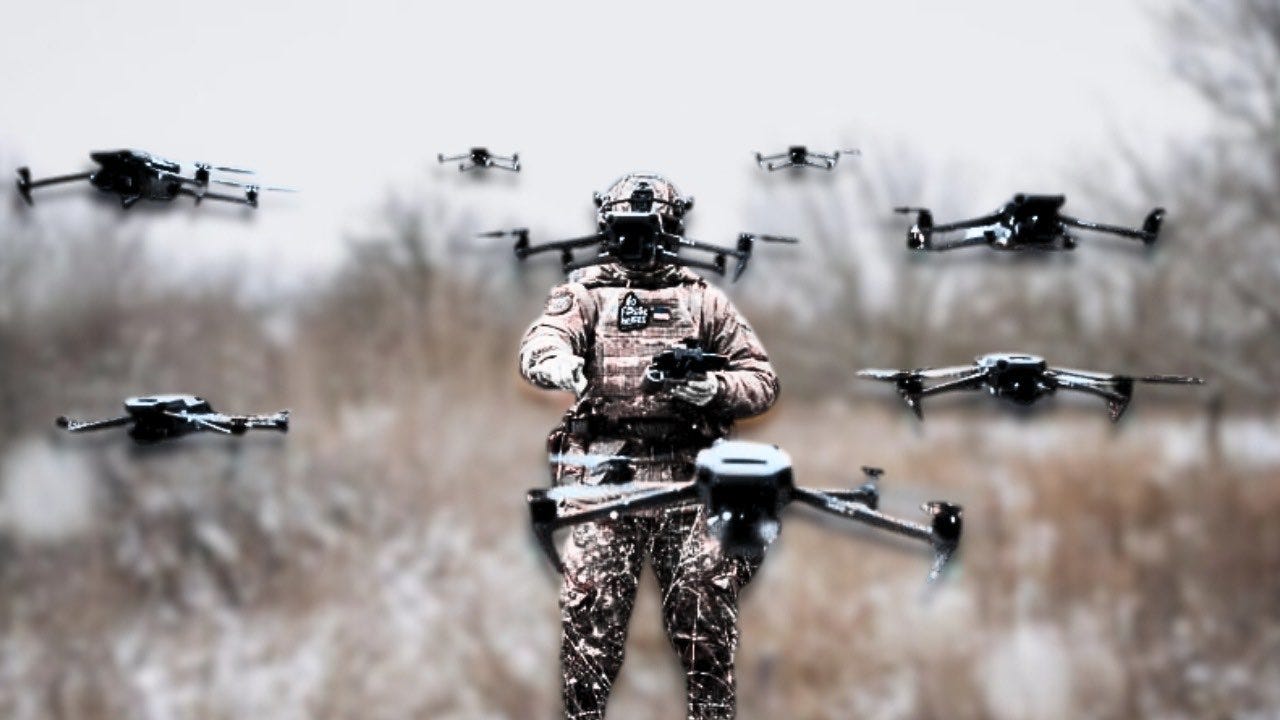Drone Warfare : Article and Podcast
Unmanned systems - pioneered in Ukraine are reshaping the balance between humans and technology in war
Precision-guided weapons first appeared in their modern form on the battlefield in Vietnam a little over 50 years ago. Since then, the cost of such weapons has soared making their use in mass prohibitively expensive for all but the United States. The cost of just one GPS guided Excalibur artillery round, for instance, is $100,000. That is why European nations ran out of precision munitions in Libya in 2011, and why the Israelis choose to use dumb bombs in Gaza.
What, though, if you could combine precision with plenty ? For the first time in the history of warfare that question is being answered on the battlefields of Ukraine, where first person view (FPV) drones have become ubiquitous. These are small, cheap, explosives-laden aircraft adapted from consumer models, and are inflicting a heavy toll on infantry and armor. FPVs can slip into tank turrets or dugouts. They loiter and pursue their quarry before going for the kill – with a 90% success rate after visual acquisition. As well as being highly effective, FPVs are simply terrifying.
FPV drones are modified racing quadcopters, built from off-the-shelf components, at a cost of several hundred dollars apiece. They tend to have short ranges, carry small payloads and struggle in bad weather. For those reasons they cannot replace artillery – at least not yet. But even these basic models can have significant effect. On more than one occasion this year, Ukrainian FPVs have destroyed Russian forces massing for attack. FPVs help explain why both sides find it so hard to mount offensives.
This week Volodymyr Zelensky, Ukraine’s president, created the Unmanned Systems Force, dedicated to drone warfare, the first of its kind in any national military. In 2024 Ukraine is on track to build 1m-2m drones – which will match its consumption of shells – an astonishing comparison.
Of course - the drone is not a wonder weapon. Its ubiquity on the battlefield in Ukraine matters because it embodies important trends in modern war: a shift towards small, cheap and disposable weapons; the increasing use of consumer technology; and the trend towards autonomy in battle. Because of these trends, drone technology will spread rapidly. And it will advance not at the budget-cycle pace of the military-industrial complex, but with the break-things urgency of consumer electronics.
The exponential growth in the number of Russian and Ukrainian drones points to a second trend. They are inspired by and adapted from widely available consumer technology, which enables the democratization of precision weapons.
In Yemen the Houthi rebel group has used cheap Iranian guidance kits to build anti-ship missiles that are posing a deadly threat to commercial vessels in the Red Sea, and disrupting global trade. In Myanmar, where rebels have routed government forces in recent days, volunteers can use 3d printers to make key components and assemble airframes in small workshops.
Innovation also leads to the last trend, autonomy. Today, FPV drone use is limited by the supply of skilled pilots and by the effects of jamming, which can sever the connection between a drone and its operator. To overcome these problems, Russia and Ukraine are experimenting with autonomous navigation and target recognition. Artificial intelligence has been available in consumer drones for years and is improving rapidly.
A degree of autonomy has existed on high-end munitions for years and on cruise missiles for decades. The novelty is that cheap microchips and software will turn the low-end munitions that are saturating the battlefield, into smart weapons. The side that can push autonomy to the edge – that is enabling each of these weapons to close the kill chain independently – will consistently out-tempo the other. Ukraine is the laboratory for this deadly competition.
Intelligent drones will also raise questions about how nations wage war and whether humans can control the battlefield. The tragedy in Ukraine is that these technological developments have bypassed the poor bloody infantryman. And his life will only get worse – until technology finds a way to seize and hold ground without putting flesh in harm’s way.





God save the infantry, the backbone of any military.
How long before FPVs jump back to the civilian sector? They could be used for mob or gang hits. They could blow up, or at least set fire to, a rival's house or car. Radical environmentalists could use them to blow up equipment or structures at a development they oppose. All while allowing the user/perpetrator to stay safely out of range & view, and if done right, rendering forensics extremely difficult if not impossible. The potential uses are endless. It's the wild west again.